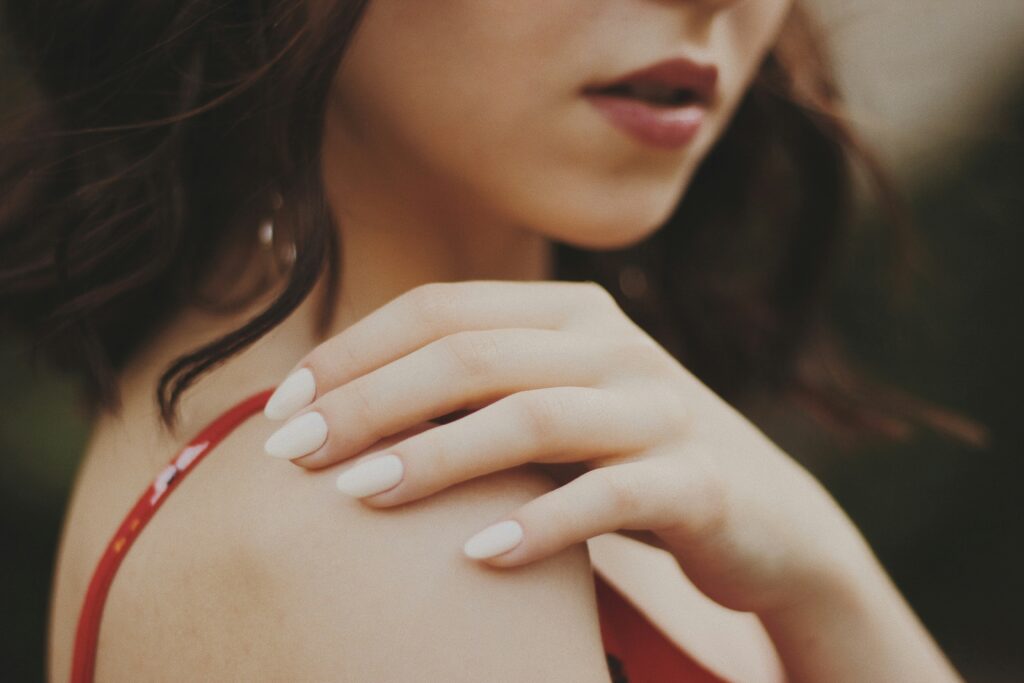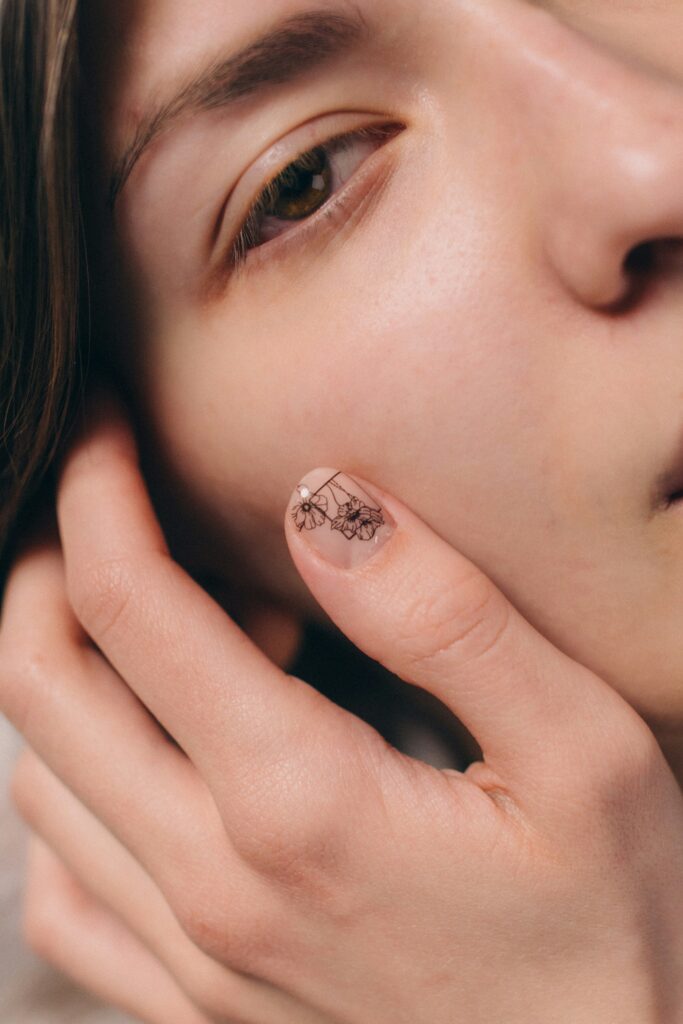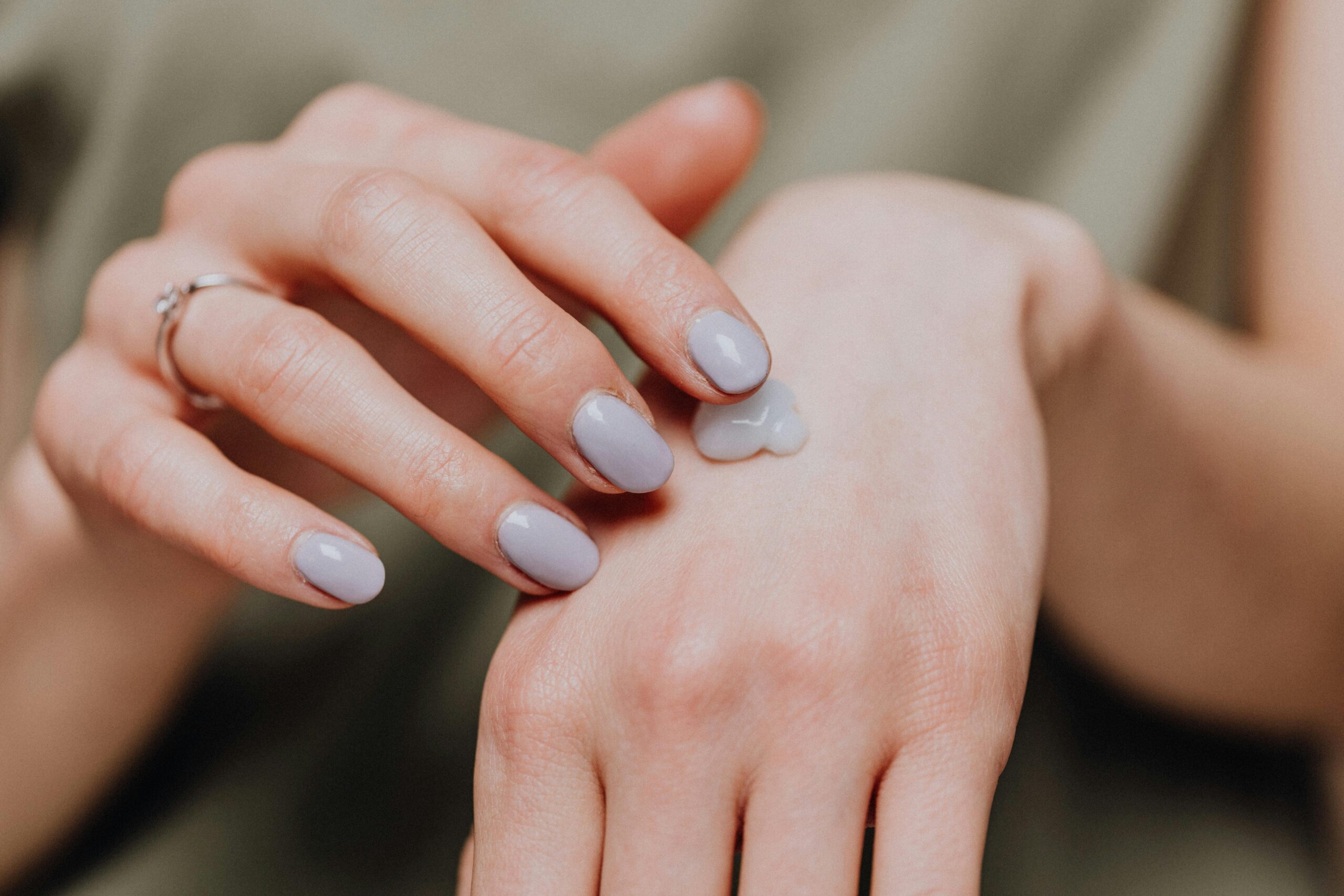Harmless Mark or Hidden Message?
There’s a good chance you’ve glanced down at your nails and noticed a small white spot. Maybe two. And almost certainly, someone at some point has told you:
“That means you need more calcium.”
The myth is persistent. The science says otherwise.
These chalky specks are surprisingly common—especially in children, beauty professionals, or anyone with a nail care routine involving polish or gels. And while they’re usually harmless, they aren’t random. In fact, these tiny white marks often hold a subtle but telling message about how your nails are being treated—or mistreated.

DrBeautiology’s Take:
- If it’s one spot, and it’s moving with growth, relax.
- If it’s multiple, symmetrical, blanchable, or persistent, investigate further.
- Don’t assume it’s calcium.
- Don’t try to scrub it away.
- Harmless Mark or Hidden Message?
- What Is Punctate Leukonychia—And Why Is It So Common?
- What Causes These Tiny White Spots?
- How Long Do White Spots Last—And Should You Treat Them?
- When to Monitor—and When It Might Be Something More
- The Calcium Myth: Debunked with Dermatology
- Preventing Recurrence: Protecting the Nail Matrix
What Is Punctate Leukonychia—And Why Is It So Common?
Let’s start with the basics. Leukonychia, in dermatology, is an umbrella term for white discoloration of the nails. It can come in many forms, from entire white nails (rare) to single dots or lines. But the most prevalent—and least alarming—type is called punctate true leukonychia.
This form:
- Appears as small, opaque white dots or specks on the nail plate
- Is caused by minor trauma to the nail matrix, the base of the nail where growth begins
- Is non-blanchable (pressing it doesn’t make it disappear)
- Moves outward as the nail grows, eventually growing off the fingertip
What’s Actually Happening Under the Surface?
The white color comes from an interruption in normal keratinization—the process of forming compact, translucent nail cells. When the keratinocytes in the nail matrix are damaged, they retain air spaces and keratohyalin granules that scatter light, creating a chalky white appearance.

These spots don’t reflect surface damage (like a scratch); they reflect something that happened in the root of the nail several weeks ago.
In other words, by the time you see the spot, the nail matrix has already healed—but the evidence is growing out with your nail.
Fun Fact: Fingernails grow at a rate of about 0.1 mm per day (3 mm/month). A spot 6 mm from the cuticle likely reflects an event about two months prior.
Why It’s So Common
Punctate leukonychia is extremely prevalent in:
- Children and teens (especially those who bite nails or pick at cuticles)
- People who regularly wear polish, gels, or acrylics
- Individuals with frequent manicures or aggressive nail prep
- Nail professionals exposed to repeated minor trauma

It’s a biological consequence of microtrauma—and in most cases, it’s the nail’s version of a bruise.
What Causes These Tiny White Spots?
Despite their benign appearance, these specks are a signal: your matrix was disturbed. That doesn’t mean you were injured or that you felt anything. The matrix is highly sensitive, and even small repetitive movements or habits can cause a temporary change in the cells it produces.
A. Microtrauma to the Nail Matrix
This is the most well-documented cause, most of the time, people don’t even realize they’re causing it.
| Common Trigger | How It Affects the Nail Matrix |
| Nail biting or picking | Physical pressure disrupts cell structure in the matrix |
| Cuticle damage from manicures | Pushing or trimming the cuticle puts stress on the matrix beneath |
| Gel polish removal | Scraping off cured gels can detach the nail from underlying cells |
| Friction or tapping | Frequent impact (e.g., typing, nervous habits) can compress the matrix |
Pro Tip: If white dots appear 4–8 weeks after a salon visit or DIY gel removal, the cause is likely mechanical—not nutritional.
B. Cosmetic Habits That Contribute
- Over-buffing the nail doesn’t cause leukonychia directly but can thin the plate, making spots more noticeable.
- Regular use of acetone, especially when combined with dry filing, increases fragility and susceptibility to minor trauma.
- Using cyanoacrylate glues (commonly found in press-ons) may indirectly contribute if they cause irritation or lifting.
C. Keratin Granulations from Polish Overuse
Sometimes confused with leukonychia, keratin granulations are superficial white patches left behind when polish is removed. Unlike true leukonychia, these are surface-level, usually chalky in texture, and do not move with the nail. They’re still worth noting—but they don’t involve the matrix.
How Long Do White Spots Last—And Should You Treat Them?
One of the most common questions people ask when they notice a white spot on their nail is, “How long will it last?” The answer lies in how nails grow.
Nails don’t regenerate instantly. In fact, they grow slowly and predictably, meaning the appearance—and disappearance—of a white spot can tell you a lot about when the underlying event occurred and how it’s progressing.
How Long Do White Spots Stay?
- Fingernails grow at an average rate of 0.1 mm per day—around 3 mm per month.
- A full fingernail takes 4–6 months to completely grow out.
- Therefore, a white spot that appears in the middle of the nail likely reflects a trauma or disruption that happened 6–8 weeks earlier.
Because punctate leukonychia forms from damage to the nail matrix—the root area where the nail is made—it doesn’t resolve overnight. Instead, the discolored section moves forward as new keratin is produced behind it. Eventually, it reaches the tip and is trimmed off.
Can It Be Treated?
Strictly speaking, no treatment is necessary. Because the white spot is embedded within the keratin, surface treatments like buffers, whitening topcoats, or nail polish removers won’t do anything to erase it. Attempting to buff out the spot may actually cause more trauma.
| Action | Effective? | Why |
| Let it grow out | ✔✔✔ | The spot moves forward with nail growth until it’s trimmed off |
| Moisturize with ceramides | ✔ | Supports healthy keratin production and nail flexibility |
| Buffing or whitening polish | ✘ | Doesn’t penetrate the nail plate or reverse matrix-level changes |
| Supplements (e.g., calcium) | ✘ | Ineffective unless deficiency is proven—and unrelated to leukonychia |

Key Insight: Punctate leukonychia is a sign of something that already happened. You can’t undo it—but you can avoid repeating it.
When to Monitor—and When It Might Be Something More
While most cases of punctate leukonychia are benign and self-limited, nail discoloration isn’t something to ignore blindly. In rare cases, white marks may signal systemic stress, nutritional deficiencies, or toxic exposures. That’s where pattern recognition matters.
What’s Normal?
You’re likely dealing with harmless leukonychia if:
- You see 1–3 scattered dots on 1 or 2 nails
- They appeared a few weeks after nail trauma (e.g., biting, gel polish removal)
- The spots are moving toward the tip over time
- You feel otherwise healthy
When to Dig Deeper
| Sign | Possible Concern |
| White bands across multiple nails | Mees’ lines—possible heavy metal exposure or chemo |
| Blanchable white lines | Muehrcke’s lines—associated with low albumin |
| Entire nail is white | May suggest systemic illness (renal, hepatic) |
| Spots that don’t move as nail grows | Likely from nail bed, not matrix |
| Accompanied by fatigue, weight loss | Evaluate for iron/zinc/protein deficiencies |
What Does “Blanching” Mean?
Blanching refers to the temporary whitening of skin or nail bed when pressed, followed by a quick return to pink as blood flow returns. In nails, this test helps differentiate apparent leukonychia (originating in the nail bed) from true leukonychia (originating in the nail plate).
- Blanchable = disappears under pressure → likely nail bed issue
- Non-blanchable = remains white → likely embedded in the plate (like punctate leukonychia)
Tip for At-Home Test: Press the white spot gently with your fingertip. If the white area disappears and returns, it’s likely due to nail bed vascular changes, not keratin defects.
The Calcium Myth: Debunked with Dermatology
Of all the misinformation surrounding nail health, few are as persistent—and incorrect—as the belief that white spots on the nails mean you’re low in calcium.
Let’s set the record straight:
Myth: White Spots = Calcium Deficiency
Reality: No credible scientific study supports this.
According to Cashman & Sloan (2010) and Cosmetic Dermatology, calcium makes up less than 0.2% of nail plate mass. It plays no direct role in keratinization, nail color, or leukonychia development.
So Where Did the Myth Come From?
Likely from a misunderstanding of mineral function. Calcium is essential for bone health and muscular contraction—not for nail clarity. If white marks reflect anything nutritional (which they rarely do), the more plausible culprits are:
- Zinc deficiency: May contribute to leukonychia in severe cases
- Protein deficiency: Can impair keratin formation
- Hypoalbuminemia: Causes blanchable nail bed whitening (Muehrcke’s lines)

Fun Fact: The calcium myth is so widespread that some beauty brands still market calcium-enriched nail strengtheners—despite the lack of evidence.
Preventing Recurrence: Protecting the Nail Matrix
Because leukonychia is about what happened weeks ago, the best strategy is prevention. That means creating a nail care routine that respects the sensitivity of the matrix—the factory under your cuticle where each nail begins.
Smart Nail Care for a Healthy Nail Matrix
| Strategy | Why It Matters |
| Avoid aggressive cuticle pushing | The matrix sits just beneath; trauma disrupts keratinization |
| Don’t peel or forcefully remove gels | Lifting layers traumatizes both nail plate and root |
| Moisturize with ceramide or urea creams | Prevents brittleness and reduces matrix stress from nail dryness |
| Use nail-safe gloves when cleaning | Protects from solvents that dry and damage nail structures |
| Limit use of acetone | Excessive removal erodes the lipid content of the plate |
| Take breaks between gel applications | Gives the matrix time to recover and re-regulate growth |

Punctate leukonychia is rarely dangerous. White spots don’t just appear randomly; they reflect how the nail was formed weeks prior.
In most cases, these spots are simple signs of over-manicuring, biting, or polish removal stress.
Have you noticed white spots on your nails recently?
Did they follow a period of stress, a new gel polish cycle, or a change in diet?
Track them. Photograph them. Watch how they move.
And let them grow—not just out, but into your understanding of how your body speaks through beauty.
Talk to you soon!
Dr Bozica
References:
https://www.sciencedirect.com/science/article/pii/S0738081X10000611?via%3Dihub
https://link.springer.com/article/10.1007/s13671-021-00345-2
https://www.mdpi.com/2079-9284/4/3/24 https://link.springer.com/article/10.1007/s40257-022-00671-6

